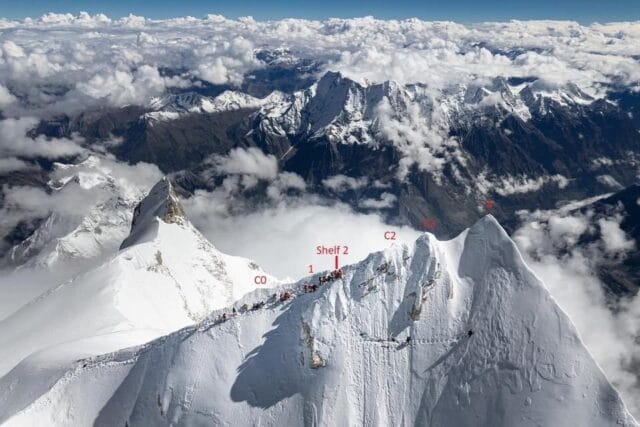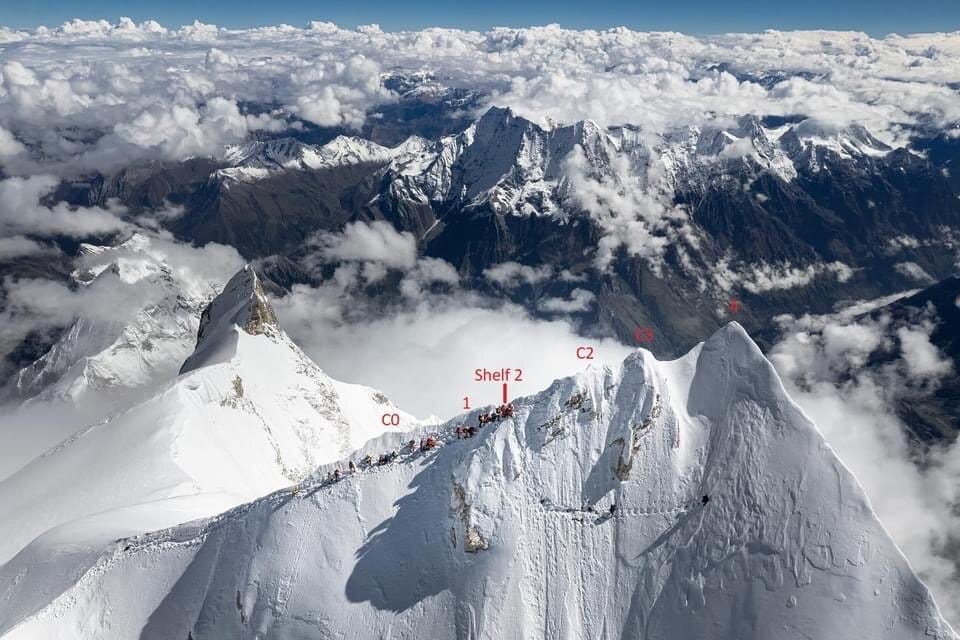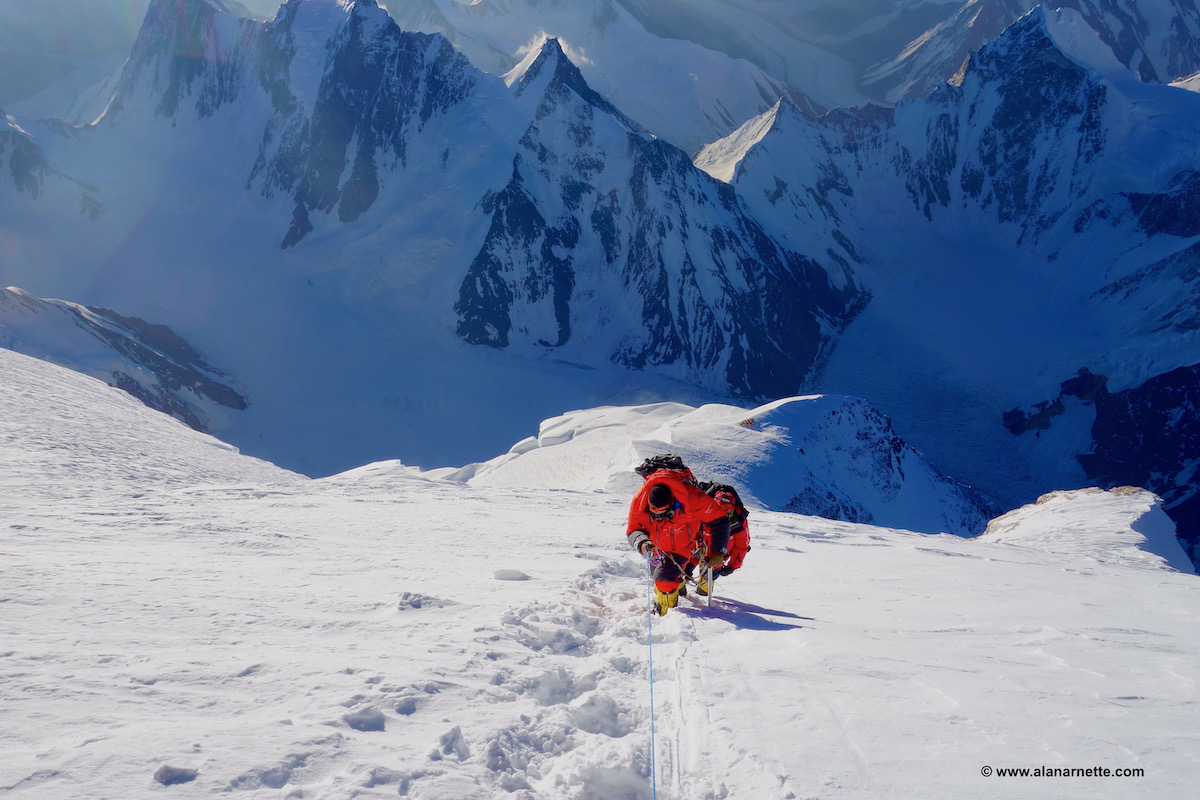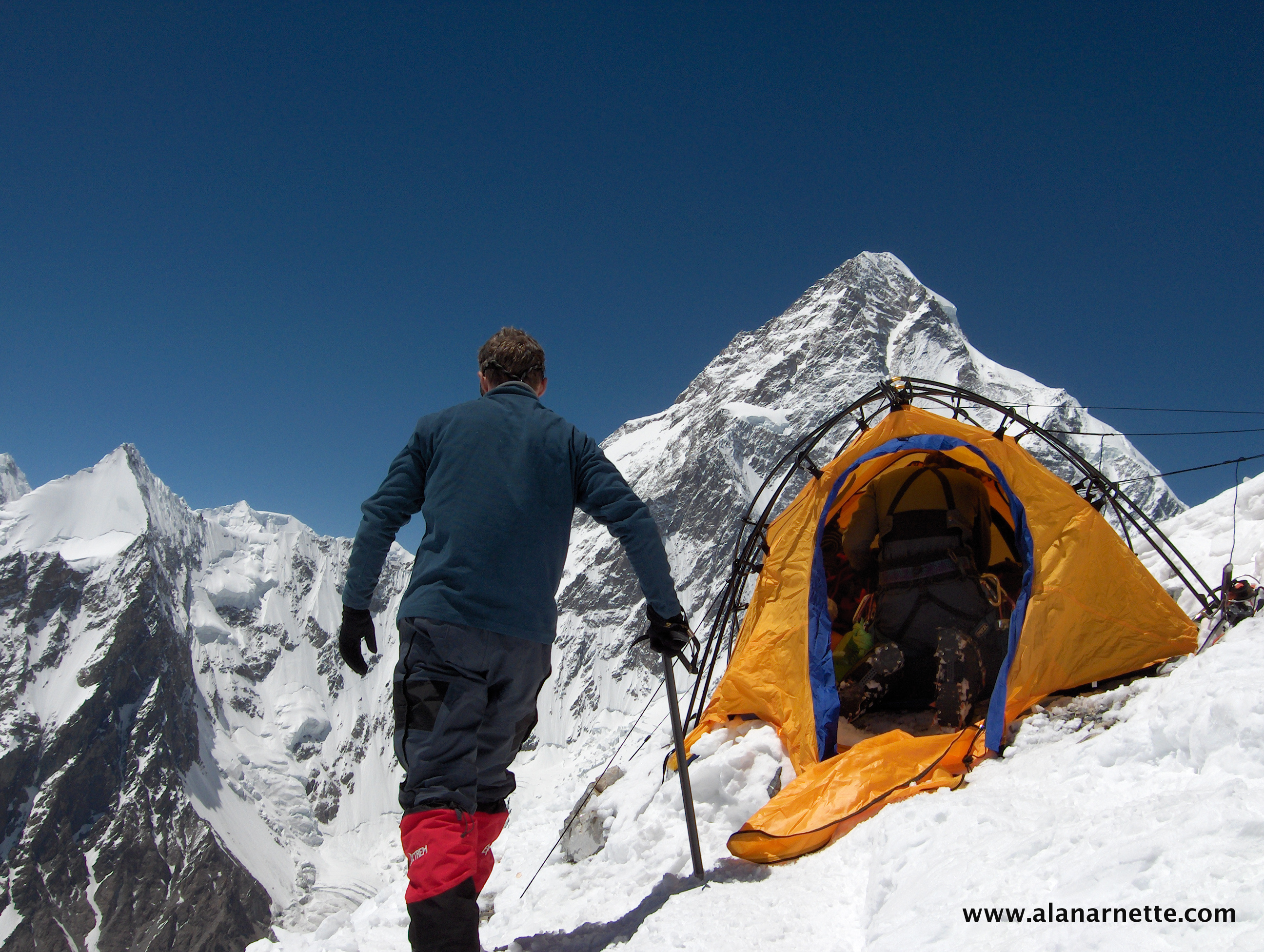The autumn climbing season is underway, with most of the attention on Nepal’s Manaslu, oft acknowledged as one of the more “attainable” 8000ers. However, many things changed last year when one team showed an alternate route to the true summit, thus turning scores of climber’s previous claims on their heels, including my own.
With an expected record crowd on Manalsu, I hope we don’t see a repeat of this spring’s and summer’s poor practices with respect to trash, excessive support, and excessive supplemental oxygen on Manaslu. However, with so much demand for these 8000ers, nothing surprises me anymore.
For many, the allure of the 8000ers is gone, as interest in following masses of inexperienced people led by massive support leaves a sour taste for many avid climbing fans. In many ways, the 8000ers have become like Kilimanjaro, Denali, Aconcagua, or the rest of the Seven Summits, attracting too many people seduced by summit promises, low prices, and rock-star style leaders. I fear we are only one unexpected situation be it weather, ques or competence from a major tragedy on the big peaks. That said, if you have the skills and experience plus choose the right team, route, and season, climbing these beasts will change your life for the better.
Here’s a rundown on what been going on in the climbing world.
Big Picture
Reaching the true summit of Manaslu requires crossing a dangerously corniced ridge or dropping below that ridge and traversing a somewhat steep slope that may be covered in soft snow or hard-packed ice, depending on the conditions that year. Either way, reaching the true summit is not for the beginner climber, which matches the profile of many of this year’s flocks on Manalsu.

As I reported last month, we can expect to see over 700 people on Manaslu, including members and supporters. The Ministry of Tourism has already issued 337 permits for Manalsu and 27 for several other peaks. As usual, the Nepali companies dominate the commercial climbs.
Permit holders are from 86 countries with the US having the most at 47, followed by India – 27, Iran – 22, Spain – 20, Argentina – 17, France – 17, Russia – 15, UK – 14, China – 12, Italy – 12, Germany – 12, UAE – 10, and Mexico at 10. Note the large presence from the Middle East. Several Nepali operators are catering to this demographic with ample oxygen and Sherpa support due to their seemingly unlimited budgets. Some will pay well over $100,000 for a climb that usually costs well under $25,000.
Multiple teams are already at Manaslu Base Camp, including:
- 8K Expeditions
- Adventure Consultants
- Elite Expeditions
- Furtenbach Adventiures
- Imagine Nepal
- International Mountain Guides
- Madison Mountaineering
- Pioneer Adventures
- Seven Summits Treks
Perhaps the most interesting sub-team to follow is Norweigan Kristin Harila who is on track to smash long-time records this year. Thus far, she has eleven of the fourteen, all with climbing Sherpas, Pasdawa Sherpa, and Dawa Ongju Sherpa, of 8K Expeditions. As she told me in my most recent Podcast, she wants the team to climb both Cho and Shish from the Tibet side if they can get permission from China. She will climb from the Nepal side on Cho if China says no, and her dream will end if they say no to Shish this year.
Everest Update – Update on Ski Descents
The only team on Everest this Autumn is from Poland, supported by Pioneer Expeditions. Andrzej Bargiel, who made history with a stunning ski descent on K2 in 2018, wants to repeat the stunt on Everest. If successful, he will claim the right to only full no-O’s ski descent on the Nepal side from the summit to, well, it’s unclear how far he has to go to claim a full descent – Camp 1, Base Camp? We will see. He is climbing with photographer Bartek Pawlikowski, cameraman Carlos Llerandi and eight Sherpas.
UPDATE: There have been other ski descents. Davo Karnicar skied all the way from Everest summit to base camp on July 10, 2000, using supplemental oxygen. Source This is the writeup in the Himalayan Database:
The 4 summiters left C4 for top 10:30 pm 6th Oct. In his continous ski descent from summit to base camp, Davo used oxygen down to South Summit because it was cold and wanted clear head; but took off 6 kg Russian oxygen system at South Summit because of weight and not possible to see down, entirely unless lowering head completely. Negotiating Hillary Step besides fixed rope but bigger problem was steep ridge below step which had to descend with skis sideways. From South Summit first 30-40m also very steep and here made short turns. At South Col “very nice place” with snow covering all rubbish. From Col crossed Spur about 20m below its top and then down Lhotse Face with big turns. Kept very close to SW Face of Everest, where no avalanche problem but serious problem to see where to go because face not straight wall. Had help by walkie-talkie with members in C2, constantly thinking about avalanche danger, “this was real pressure – man can do nothing” if serac suddenly fell at him. Had no accidents. “You must have something inside” with strong motivation to get up to start. Left summit at 8:00 am and reached South Summit 8:20 am reached C4 at 8:40 am, C2 11:00 am and stopped for drink and waited for movie cameras to be ready from BC. Left C2 11:30, C1 11:50 am, BC on 12:40 pm. Total 4 hours 40 minutes from top to BC. No sleep between C4 up and return to BC but not immediately sleepy. Expected to take 5-7 hours. “Emotion did not come immediately.” Left slowly over days. Wants to do all other 7 summits. Maybe use some special type “skis” but probably not at all on Karstenz and Kilimanjaro, only short distance of snow (has done Elbrus 1987).
This is from Elizabeth Hawley in 1997 on Hans Kammerlander ski descent (almost complete) on the Tibet side:
Not all the notable events on Everest were tragic, but the happy results received scant public attention. They deserved better. One example: two weeks after the fatal storm, the 39-year-old Italian, Hans Kammerlander, successfully scaled the normal route from the Tibetan side with astonishing swiftness after having acclimatized on one of the 8000-meter summits of nearby Shishapangma. Although there was a camera crew with him on the lower part of the mountain, he climbed alone steadily through the night of May 23, and managed to cut more than four hours off the previous speed record for an ascent of his route, which had been set in May, 1995, by another Italian from the South Tirol, Reinhard Patscheider. In only 16 hours, 45 minutes, Kammerlander ascended from Base Camp at 6400 meters to the 8848-meter high top of the world. He then proceeded to ski down almost the entire length of the same route (he could not use his skis on rocky sections that he claimed totaled only 250 vertical meters) in six hours, 45 minutes, thus having accomplished the round-trip in the truly remarkable total elapsed time of 23-and-a-half hours. Patscheider had taken 21 hours to go from base to the top. Despite not having used any bottled oxygen, and therefore having felt slightly drunk very high up, Kammerlander returned safely to his base in good health, although much thinner.
No Permission, No Summit Certificate
The usual post-Everest season antics reveal more difficulties with the Nepalese Government and visitors and their operators, not following rules.
Climbing with Elite Expeditions, Mexican Juan Diego Martinez Alvarez, 19, is said to have paid $350,000 to the high-profile operator so that he could play his electronic keyboard on the summit of Everest. He did and subsequently posted the obligatory selfie videos all over social media but now has no summit cert to show off at parties. Nepali authorities said his guide never asked for permission to play a keyboard on the summit, and thus he broke the regulation. I’d be curious to see where a rule says, “Playing an instrument on Nepal summits is only allowed with previous permission.”
And Russian Katya Lipka climbed with 8K Expeditions, flew a Ukrainian flag on top of Everest without permission, and had her summit cert revoked. It would be interesting to see what penalties were charged against the team that draped the summit of Ama Dablam with a Kuwait flag in 2019.
So all these rules stuff is not limited to Nepal; it seems climbing the Matterhorn from the Italian side was banned due to rockfall and dangerous conditions this summer but ignored by two climbers. Unfortunately, they got themselves into the deep end of the pool and had to be rescued. Authorities said the Czech and Slovak climbers were climbing illegally and fined them USD$3500 on the spot. I doubt they had that much cash on them. Note that as of this post, the route has been reopened.
Climbing Deaths
This summer has seen more deaths than usual across the world. On August 28, two very experienced climbers died, reportedly from carbon monoxide poisoning, while in their tent on Kyrgyzstan’s Lenin Peak (7,134m) 38 years old Vyacheslav Sheiko was guiding Georgiy Veselovsky.
A Russian team of ten men and two women, with two guides, lost nine members while climbing the Klyuchevskaya Sopka volcano, 4,754m, Eurasia’s tallest active volcano. Most of the deaths were said to be due to falls.
Edmonton resident Matt Miller, 42, fell more than 3,000 feet on Mount Temple near Lake Louise. Reports said he lost his footing and slipped on a patch of snow and ice.
Here in my home state of Colorado, a female climbing alone died when a rock she was using as a handhold gave way on the so-called Knife-Edge on Capital Peak. It was the last of her quest to summit all 54, or 58, depending on how you count them, peaks higher than 14,000 feet in Colorado. Capital is known as one the most deadly in the State due to loose rock and difficult route finding at times.
K2 Permit Increase
Under the guise of reducing crowds and cleaning up the trash left behind by commercial teams, Pakistan announced the permit fee for K2 will rise from $7,000 to $12,000, now exceeding the fee for Everest of $11,000 on the Nepal side. No word if they will limit the number of permits issued and have reasonable experience requirements for clients or guides. As I said during the season, Pakistan caught the permit greed flu from Nepal and is on course to repeat all of its previous and current missteps in managing its natural resources. All Pakistan has done with this fee increase is to increase its coffers.
Apple, Beam Me Up
Apple introduced new iPhones yesterday that support emergency satellite communication similar to Gamnin or SPOT devices. It will be offered at no charge for the next two years and is designed to support remote adventures where cell service is unavailable. Once the line of sight is made with a satellite, the user can send a text message that will be relayed to authorities for help. It appears not intended for casual texting.
Perhaps of interest to climbers is the new Apple Watch Ultra. This model has a large display with situational high contrast, a monochrome red-on-black effect, GPS, and cell phone capabilities. It can talk to the sats if it’s near an iPhone 14. And it has an 86-decibel siren that can be heard up to 600 feet away, depending on the terrain, that could be useful to scare away bears or attract a SARs team.
The battery can last up to 60 hours, but around 36 in normal mode. It has the usual tracking map, heart-rate monitor, body temperature and EKG monitor, and other features users of Garmin, Sunitto, and Casio have. Oh, and if you get lost, and the siren or GPS track won’t help, you can always say, “Hey Siri, where am I?”
Climb On!
Alan
Memories are Everything
The Podcast on alanarnette.com
You can listen on Spotify, Apple, Google, Pocket Casts, RadioPublic, Anchor, and more. Search for “alan arnette” on your favorite podcast platform.
Summit Coach

If you dream of climbing mountains but are unsure how to start or reach your next level, from a Colorado 14er to Rainier, Everest, or even K2, we can help. Summit Coach is a consulting service that helps aspiring climbers worldwide achieve their goals through a personalized set of consulting services based on Alan Arnette’s 25 years of high-altitude mountain experience, including summits of Everest, K2, and Manaslu, and 30 years as a business executive.




